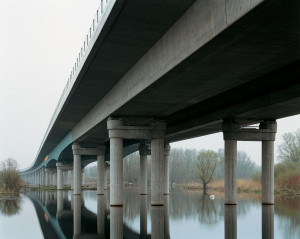Hans-Christian Schink
EXHIBITION Apr 28 — Jun 24, 2006
Exhibition Text
In the exhibition projects "Hans-Christian Schink: Vietnam" (Kicken I) and "Stephen Shore" (Kicken II), which are on display at the same time, Kicken Berlin honors two outstanding practitioners of contemporary color photography. Thus the gallery represents two positions within the genre: from the rediscovery of color photography in the United States of the 1970's to present day Germany. STEPHEN SHORE (1947) and HANS-CHRISTIAN SCHINK (1961) not only have a distinct visual language that distinguishes their work, but they also share a special type of vision that allows them to illustrate, with remarkable restraint, the feeling of ambivalence towards the all too commonplace and the strangely peculiar that is inherent in every day life.
Hans-Christian Schink, was born in Erfurt in 1961 and is one of the most interesting color photographers active today. His large format work is executed with fascinating technical perfection, displaying immense detail. Schink studied photography at the Academy of Visual Arts in Leipzig from 1986 to 1991 then proceeded with graduate studies from 1991 to 1993. In the mid-1990's he created a series depicting residential, commercial, and industrial buildings in which architectural forms turn into impenetrable surfaces. These are for the most part massive, unapproachable surfaces with little to indicate that their primary purpose is to create functional space for people. The series "Verkehrsprojekt Deutsche Einheit", (German Unification Transportation Project) made in 1998–2001, portrays the infrastructural reunification of Germany in the late 1990's as an architectural-constructive reality. The photographs of these construction sites reveal the ambivalence at the heart of these projects, even put it on display: he depicts the moment of still stand. Are things being built or taken apart? Is this construction or deconstruction? Although people are absent in Hans-Christian Schink's photographs, traces of human activity are everywhere. It is precisely this deserted state, with its extraordinary, pervasive silence that allows these photographs to prompt the question: how deeply does human intervention form and deform natural space? This is evident in the projects Hans-Christian Schink has done in the past few years, especially in the 2005 series "Vietnam", which is on public view for the first time in this exhibition. Many of these beautifully exotic images show the Vietnamese landscape and stone cultural heritage objects. On closer inspection, intrusions become apparent: telephone cables, electrical transformers, loud speakers, and street lamps cut through nature and sacred temple architecture alike. Schink's photographic analysis of the present started out biographically with an examination of the changes taking place in Germany and his Vietnam series now culminates with the visible communication network and infrastructures of advanced globalization. An aesthetic of disruption, such as power cables cutting through idyllic nature, is a focus of his photographic perception and it affects all of his series. (Mareike Stoll)

